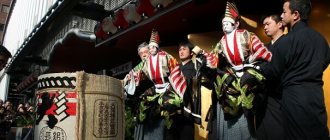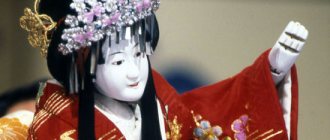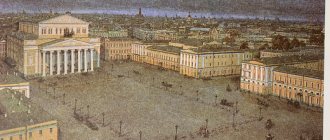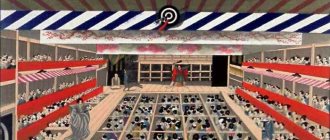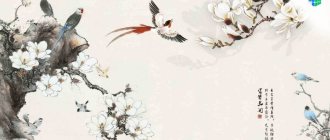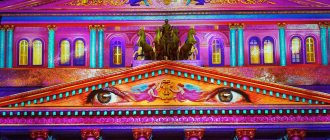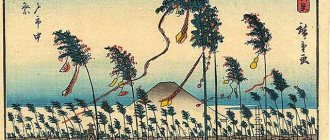Historical reference
The emergence of theatrical art in general, and theater in particular, is usually attributed to the last quarter of the 14th century. It is believed that the development of high theatrical art began in 1375 in the city of Nara, at the Kasuga Temple with the blessing and support of the young shogun of Japan, Ashikaga Yoshimitsu.
The founders of this type of theatrical performance are considered to be Kan'ami Kiyotsugu (1333-1385) and his successor Zeami Motokiyo (1363-1443).
At that time, Noh theater was a rather unsophisticated genre of entertainment for the common people, which included elements of dengaku (Japanese 田楽, associated with Shinto religious rituals), sarugaku (Japanese 猿楽, a type of acrobatic performances that later transformed into song and dance performances), traditional Chinese dances and song ballads that shaped the oral traditions of folk art.
Japanese theater "Joruri"
“Joruri” is a puppet theater in Japan whose origins can be attributed to puppet shows staged by hunters.
The performances took place right on the street, moving from house to house. Later, performances with the participation of dolls began to be performed by wandering monks, followers of the Buddhist sect Jodo . For their performances, they used small homemade stages on which they told stories and Buddhist plots with the help of dolls.
Later, traveling puppet shows were combined with sekkyo , musical retellings of Buddhist stories, which contributed to their growth in popularity. In the first years of the Tokugawa sekkyo's , they penetrated deeper into the sphere of popular hobbies.
The development of this art was helped by musical accompaniment and the secular nature of the stories, which acquired a love overtones. The earliest text Joruri The History of Joruri , which gave the genre its name. The story about the love between the hero Minamoto Yoshitsune and Joruri, the daughter of a merchant, was successfully combined with puppet shows and playing the shamisen.
Famous representatives of this genre were Jokey Joun, Gendayu, Miyauchi Gidayu. With the arrival of these outstanding performers in Kyoto, puppet theater experienced a new era of prosperity.
The Rise of Noh Theater
During the Muromachi period, Noh theater reached a form that has survived virtually unchanged to the present day. This theatrical genre had a huge influence on other types of Japanese dramatic art (kabuki, butoh). Despite the fact that during the Meiji period Noh theater lost the patronage of the authorities, it was among the officially recognized national forms of theatrical art.
Zeami Motokiyo, the founder of the Noh theater tradition, is himself the author of several plays. He also wrote a treatise in 1423 on the skills needed by Noh actors. These plays, as well as the treatise itself, are still relevant today.
The turning point in the fate of Noh theater is considered to be the production of Zeami's play, dedicated to the events of the Heian period (Japan's Golden Age). This play was written, as they say now, in a high style, with amazing passages and hidden meanings in the plot lines. Obviously, this production led to the fact that Noh theater firmly took the place of an elite theater, an art for the nobility and the upper strata of Japanese society (as opposed to the Kabuki theater, for example).
Features of the Japanese traditional theater "NO".
Due to the pandemic, Japanese traditional theater did not come to Lincoln Center in Manhattan. He comes to almost all festivals. There are many modern theaters in Japan and most of them are very good, but only the two oldest ones come here. One plays everything without changes for hundreds of years, and the other plays new plays according to the old version, from tracing paper that is 400 years old.
The beginning of all theaters in the world comes from traveling artists. With the development of society, sedentary groups appeared. Some were created by rich people, others by religious communities. Christianity gave birth to church singing, rich people revived ancient drama, and in Japan Taoist monasteries attracted them to popularize rituals. Much later, urban nobility all over the planet already wanted to have their own theaters.
Thus, Japanese sarugaku actors had the opportunity to become familiar with religious literature and the chanting of monks. They moved from depicting everyday and satirical scenes to plays with religious and philosophical content. These new plays were called “BUT ”
(the character 能 means “skill”).
Scenes praising deities and great people required a certain skill and careful preparation, so their performance was of a high level. The song and dance prayer play “
OKINA
”
(“The Elder”) has survived to this day. By the end of the 14th century, there were a large number of sarugaku no troupes in Japan. Treatises on theatrical art were passed down from generation to generation. At the end of the 16th century, changes occurred in the appearance of the performance. Extremely expensive suits appeared; they were also inherited as family heirlooms. Portrait masks were replaced by masks with a mysterious, elusive expression. In the era of urban culture, NO actors are considered to be the lower class of samurai, and they are now required to adhere to a special code. For example: 1. actors are prohibited from having excess property, except for costumes and household utensils, 2. actors are prohibited from leaving their family profession and studying martial arts, as well as other arts that do not correspond to their position. The era revived the original nature of the NO theater, giving importance to its ritual side. It was believed that a well-performed performance contributed to the prosperity of the state. For carelessness in acting, the actor could be sent into exile or sentenced to seppuk - a samurai ritual of ripping open the abdomen. Since then, everything in the NO theater - stage, props, costumes, masks, gestures, dance, intonation - has been canonized.
Speaking about modern theater BUT I would like to mention the name of Yukio Mishima. Thanks to his work, the national form returned to post-war Japanese theater. The mask plays he created between 1950 and 1955 are still on Japanese stages. Many of his works have something in common with classical dramas; the author invents the plot, changes the external outline, the location of the action, the social affiliation of the characters, but maintains the traditional structure. Mishima died as a result of seppuku, but that's a different story.
The classic drama BUT has a small cast of characters: from three to five people. The main character site, as a rule, appears in two guises. The second waki character plays on behalf of the viewer. These two characters often have companions: tsure - the companion of the shite and wakizure - the companion of the waki.
Another important participant is the chorus, which speaks the internal monologue of the site or explains his actions. The cast of characters often includes an intermediate farce character, ai. Site, having played the character, moves deeper into the stage to change his costume and then Ai appears to retell the fate of the main character in simple colloquial language. He seems to be a local resident, so he simply answers the waka's questions.
Depending on the character of the main character, dramas are divided into cycles: about gods, men, women, demons and madmen. The drama should illustrate Buddhist truths: 1) life is suffering; 2) suffering arises from indulging one’s passions; 3) you can get rid of suffering only by freeing yourself from passions. The plot of the dramas is one-act and boils down to the following: waki meets a local resident of site. A dialogue arises between them, and at some point the waki realizes that he is being told a story from a long time ago. Then the site reveals that he is a spirit, asks to pray for his repose and disappears. At midnight he returns in a new guise and talks about his sufferings during life and after death. In this part of the play, he performs a dance symbolizing the extreme degree of his mental state. And in the end he achieves enlightenment or goes into darkness. Nature is animated and personifies the mood of the hero. Autumn and winter - loneliness, sadness, loss. Spring – happiness, love, hope. Summer is a time for demons.
The acting technique BUT is a mixture of pantomime and dance, which consists of 250 basic movements (kata). The first thing an actor learns is a special gait. Touching the heel, the toe rises slightly, the foot slides on the heel for a while, then lowers onto the toe. The movements can be simply dance, they can symbolize emotions: shiori - a sad state or crying (the fan is closed, the palm of the left hand slowly rises to the eyes, the face is lowered). Can symbolize nature: tsuki no ogi - admiring the moon (touching the left shoulder with an open fan, the face is raised and turned upward to the right).
Only the site wears a mask. There are four categories of masks: elders, warriors, women, demons. The small size of the mask corresponds to the aesthetic ideals of the era in which it was created; it was considered beautiful to have a small head with a large body. By the age of twenty, having gone through the difficulties of the first stage - walking, wearing a mask in which almost nothing is visible, feeling the stage, the actor gains the right to play the roles of young beauties and young warriors. After thirty, he masters the difficult roles of seasoned warriors, demons and gods. And only after fifty or sixty years can an actor play the roles of old women, and the most complex roles of madmen. Perhaps the distinctive feature of the BUT theater is the masks in which the actors perform plays. Masks have a dual function: on the one hand, personifying the character; on the other hand, masks convey certain emotions and inner experiences of the characters, as in ancient Greek dramas. However, fans play an equally important role in theater productions. They replace all the necessary props, if necessary turning into a sword, a smoking pipe, or a sake bottle.
Without a basic understanding of the tradition of theaters, you can die of boredom there. You need to prepare for visiting a foreign theater. During my school years, the Royal Shakespeare Theater came to Leningrad. My friend and I managed to get to the performance of “King Lear”. The idea was to listen to the old pronunciation of English. We had no idea that the costumes would be rather poor and the stage would be practically empty. It was a traditional production, not a modern one. Both “young victims of Hollywood” simply listened to the text with their ears and followed the book with their eyes. The next day, answering the question:
-So how did you like it?
Answered honestly:
-I haven’t been this tired for a long time.
-What was there to see?
-One high chair and grandfather sat on it.
It just seems like 250 movements is a lot, you need to know the meaning of each of them, then the play can be read by movement. I wasn’t ready to go to Lincoln Center, and I wouldn’t dare go now. But I was lucky enough to be in Nashville for the Tea Ceremony show. It is not as complex as a play, but also in the tradition of BUT. Despite my knowledge in many matters, the tea seemed warm to me, there was little of it and the performance lasted a very long time. The pace of modern life is to blame for this. Even after reading what you see, you will lose inside at a different speed.
Nakamura-za's "family enterprise" has been preserving the Kabuki tradition for almost four centuries. Today it is run by the nineteenth generation of Nakamura. However, the Kyoto theater NO Kanze Kaikan is almost three centuries older. It is led by a direct descendant of the founder of the NO genre in the twenty-sixth generation, Grand Master Kiyokazu Kanze. NO theater is built on demonstrating the hidden meanings and internal states of characters. The scenery, most often, is sparse or absent altogether, and the laconicism and symbolism of the actor’s gestures are designed to awaken the viewer’s imagination. The actors are usually assisted in this by singers in the background.
The tradition of Kabuki is the constant search for new forms. For example, on the theater’s first visit, in the final fight scene, the back of the stage suddenly opened to reveal a view of Amsterdam Avenue. An entire New York police unit entered the stage without disturbing the harmony of the performance.
As for the NO theater, here the ancient traditions are untouchable. The first NO plays were dramatized Shinto shrine ceremonies. Later, the plot appeared in plays, but was never developed. They lack the foundation of dramatic action - conflict. This is the BUT genre.
The audience is not interested in drama in the performance, but in the grace and nobility of movements that convey the sensuality of spiritual impulses. Many plays end with a dance that is not necessarily related to the plot.
All NO theaters are similar to each other: the floor of the stage is lined with cedar planks, oriented to the corner, four columns support the ceiling, similar to the roof of a Shinto shrine, on the left wall there is a pine tree, a symbol of longevity and a hashigakari bridge leading the main character to the “mirror room” behind stage.
Zeami, the creator of the NO theater, wrote that “yugen are the thin shadows of bamboo on bamboo.” Yugen is what is hidden under the words, what the NO theater actor must extract from the text of the play. In the treatise “Notes on the Flower of Style” (XV century), he wrote that “snow in a silver cup” is a flower of calm, silence, tranquility; an actor’s play can reveal this flower, which is usually not visible. Hidden, hard-to-attain beauty is valued within the yugen aesthetics more than obvious beauty.
The key concepts in Zeami's teachings are: the hidden beauty of yugen, imitation of monomane and the stage charm of the han actor. Zeami believed that an actor must not only possess the skills of acting, but also nurture within himself, and then convey to the audience the atmosphere of beauty hidden in the nature of things, that is, introduce into the performance exquisite elements, especially music and dance, external splendor and technical perfection . According to the teaching, “Yugen dance consists in making the movements beautiful, the whole appearance cute and so that the audience is interested,” and the actor must even perform the role of a demon in the spirit of Yugen so as to charm the viewer, and then the demon character will be like “a sheer cliff.” , on which flowers grow." According to Zeami, “intimate beauty” constitutes the life and soul (so-called kokoro) of any thing, and the disclosure of yugen is the basis of the actor’s influence on the viewer, awakening in him reciprocal emotions - yojo (“emotional echoes”).
The word monomane (物真似, “imitation”) originally referred to an exaggerated game that conveys the characteristic features of characters taken from life, a comedic and grotesque transformation into an image. The monomane was reinterpreted by Kan'ami Kiyotsugu, Zeami Motokiyo's father: by this term he meant an imitation of the nature of things, driven by aesthetic taste. Struck by the graceful manner of playing in the yugen style, which he saw in the Omi province, Kan'ami changed the style of his own playing, deciding to combine two principles - “imitation and refinement.” His son substantiated the unity of monomane and yugen in his treatises. Zeami described the art of imitation with the help of the concept of nariiru (a variant of the word narikaeru - “entry, appeal”): “first - to become (nariiru) the subject of the image, then - to resemble it in action.” According to Zeami’s classification, in the NO theater there are three types of roles to be imitated (the so-called santai - “three faces”): the old man (rotai), the woman (jutai) and the warrior (guntai).
The third basic concept of han (花, "flower") denotes the stage presence and charisma of the performer. Zeami identified two types of “flower”: Temporary (jibun no hana) and True (makoto no hana). A temporary flower is the result of natural beauty, which dies when youth passes, while a true flower is the result of many years of training. Such a “flower” can only be experienced by a spiritually mature person, and if by the age of thirty or thirty-five the actor has not yet known the True Flower, then after forty years his skill will begin to decline, although the withered “flower” retains its aroma for a long time. An actor who has opened and preserved his “flower” is able to charm the viewer until the end of his life.
Zeami cited Kanami as confirmation of this:
-My father died at 52 on May nineteenth; and on the fourth of May he performed BUT at the Sengen Temple in Suruga Province. His performance that day was especially magnificent, and all the spectators unanimously admired it. By that time, my father had ceded almost all the best roles to young actors, and, as best he could, in a calm manner he performed roles that were more appropriate to his age. However, he did it so skillfully and uniquely that his performance looked more beautiful and perfect every time. He achieved this because he reached the True Flower. His art resembled an old tree from which the leaves have fallen, but beautiful flowers are still fragrant on it.
Writing a few pages with the Internet is quite easy on the one hand, but on the other it is difficult to convey the state of the viewer. Until you yourself feel powerless to understand what is happening on stage, you will not be able to write anything. Is it necessary to go to such shows? Rather, it is possible if you have a genuine interest in the movements of the actors and you are imbued with the spirit of that time. I hope that after reincarnation I will wake up in Japan and I will be able to watch BUT performances again through the eyes of a local “site” resident.
Aesthetics of Noh Theater
Perhaps this long-lasting popularity is due to the inescapable pomp and beauty of Noh theater productions, which are unlikely to be found anywhere else. It is no coincidence that the name No is often associated with the concept of yugen , thanks to the nobility and elegance of theatrical performances (this is especially true of plays dedicated to the poetess and famous beauty Ono no Komachi who lived during the Heian period, telling about her older years, when she lost her former beauty and position, but has not lost its shine). Strict simplicity and grace make this type of dramatic art truly unique.
In addition, in Noh plays there is a certain abstraction based on the desire to show the audience not the forms and external attributes of characters and phenomena, but their hidden essence and spirit. - This is a unique song genre, although the quiet, drawn-out chants themselves occupy relatively little space in the production, giving way to fast recitatives. Music is not the main element of the performance, but the lyrics are presented in poetic form in traditional Japanese meter 5-7 (which later developed into the genre of Japanese haiku poetry); they are not so emotional, but full of subtle hints and hidden meaning.
Role performers in Noh theater are divided into four main categories: shite, waki, kyogen and hayashi .
Shite is the most common category of noh actors. It includes the following varieties: shite (Japanese 為手, main actor) tsure (Japanese 連れ, partner of the site) jutai (Japanese 地謡, chorus, usually 6-8 actors) koken (Japanese 沽券, supporting actors, 2-3 people). Waki (Japanese: 脇) play the opposite characters to Shite. Kyogen (Japanese: 狂言) perform aikyogen interludes. They also perform in independent plays between acts of noh. Hayashi (Japanese: 囃子) are musicians who play four traditional no instruments: the flute and three types of drums.
Usually all categories of actors participate in the production. The performance lasts from 30 to 120 minutes. The performances themselves are thematically divided into five types:
divine military women demonic mixed
Kamiuta (Japanese: 上歌) is an independent type of performance that combines dance and Shinto ritual. Such plays are considered the oldest in the Noh repertoire.
Japanese theater "Yose"
"Yose" is a traditional Japanese chamber comedy theater . The performances of this theater are based on comic, satirical stories, anecdotes, full of puns and often have an unexpected ending.
Due to the fact that this form of the genre developed in the period from 1600 to 1912, the content of these productions tells about a way of life that is little familiar to modern listeners, but given this situation, many performers working in this genre today write their own stories, reflecting modern reality.
There is only one main person in the performance - the performer himself, dressed in a kimono and sitting on the stage, on a special pillow. A fan and a towel are used as props.
Noh theater masks
One of the most distinctive features of the productions is the tradition of wearing masks (Japanese: 能面, no: men or Japanese: 面, omote) by both the main character ( shite ) and his partner ( tsure ). Masks transform the site into an old woman, a youth, a woman or a supernatural creature. The mask, however, is not worn when the site is playing a mature man. Teenage actors (kokata, Japanese: 子方) and actors playing supporting characters do not wear masks.
Masks are carved from wood, often cedar is used. They are then covered in plaster and painted, with some masks being outstanding sculptural works in Japanese art. There are quite a few types of masks, which requires some knowledge of them in order to distinguish them from each other.
Another distinctive feature of noh is the fan, which can appear in the play as a symbol of various objects (sword, pipe, bottle, etc.).
